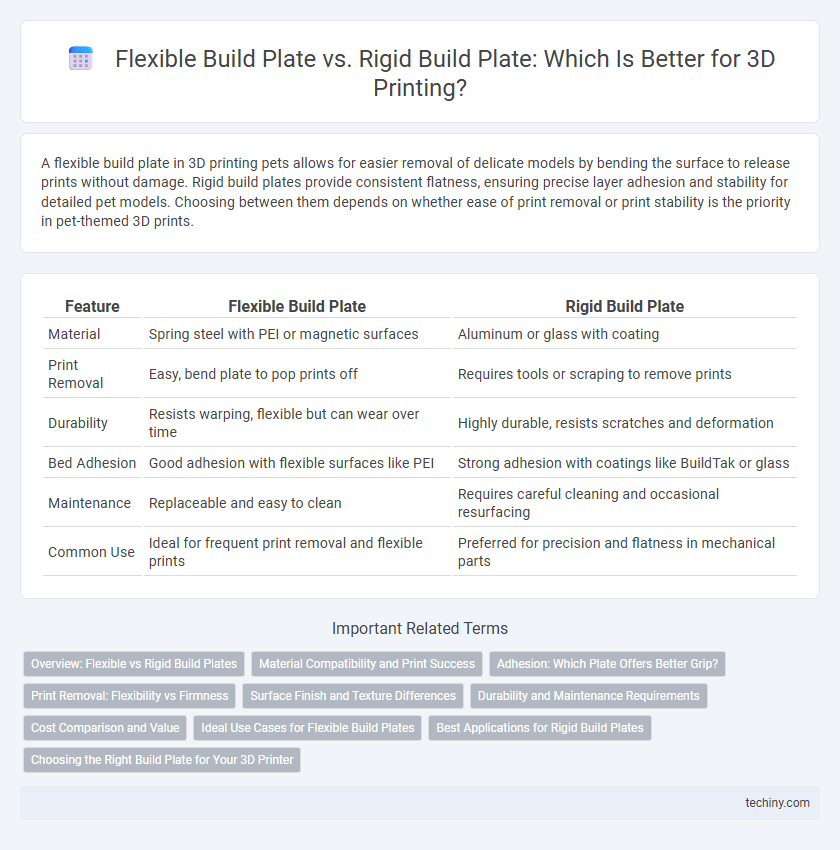A flexible build plate in 3D printing pets allows for easier removal of delicate models by bending the surface to release prints without damage. Rigid build plates provide consistent flatness, ensuring precise layer adhesion and stability for detailed pet models. Choosing between them depends on whether ease of print removal or print stability is the priority in pet-themed 3D prints.
Table of Comparison
| Feature | Flexible Build Plate | Rigid Build Plate |
|---|---|---|
| Material | Spring steel with PEI or magnetic surfaces | Aluminum or glass with coating |
| Print Removal | Easy, bend plate to pop prints off | Requires tools or scraping to remove prints |
| Durability | Resists warping, flexible but can wear over time | Highly durable, resists scratches and deformation |
| Bed Adhesion | Good adhesion with flexible surfaces like PEI | Strong adhesion with coatings like BuildTak or glass |
| Maintenance | Replaceable and easy to clean | Requires careful cleaning and occasional resurfacing |
| Common Use | Ideal for frequent print removal and flexible prints | Preferred for precision and flatness in mechanical parts |
Overview: Flexible vs Rigid Build Plates
Flexible build plates offer enhanced convenience by allowing easy removal of prints through gentle bending, reducing the risk of damaging delicate models; they are typically made from materials such as spring steel with a PEI or textured surface for better adhesion. Rigid build plates, often constructed from aluminum or glass, provide a stable and flat printing surface that ensures consistent layer height and improved first-layer adhesion, which is crucial for high-precision prints. Choosing between flexible and rigid build plates depends on print material compatibility, ease of print removal preferences, and the desired level of surface finish quality.
Material Compatibility and Print Success
Flexible build plates excel in adhesion for a wide range of materials such as PLA, TPU, and PETG, reducing print failures caused by warping or detachment. Rigid build plates, typically made of glass or metal, provide stable, flat surfaces that are ideal for high-temperature materials like ABS and Nylon, improving layer adhesion and overall print quality. Choosing the appropriate build plate based on material compatibility directly enhances print success rates and reduces post-processing effort.
Adhesion: Which Plate Offers Better Grip?
Flexible build plates typically provide superior adhesion due to their textured surfaces and compatibility with various filament materials, reducing warping and improving print stability. Rigid build plates, often made of glass or metal, offer consistent flatness but may require additional adhesion aids such as glue or tape to prevent print lifting. Choosing between flexible and rigid plates depends on the specific filament type and desired ease of part removal after printing.
Print Removal: Flexibility vs Firmness
Flexible build plates simplify print removal by allowing users to gently bend the surface, causing parts to easily detach without damage, which is particularly beneficial for delicate or intricate prints. Rigid build plates offer a firm foundation that reduces print warping and increases adhesion stability, but often require tools for part removal, potentially risking surface scratches or print damage. Selecting between flexible and rigid build plates directly affects user experience during post-processing, balancing ease of print removal against print stability and surface durability.
Surface Finish and Texture Differences
Flexible build plates typically offer a smoother surface finish due to their ability to slightly bend and ease part removal, reducing the risk of surface imperfections like scratches or warping. Rigid build plates provide consistent texture with firm support, often resulting in a more uniform bottom surface but a higher chance of adhesion marks or minor surface irregularities after detachment. Material compatibility and printer settings also influence texture outcomes, making the choice between flexible and rigid plates crucial for achieving desired print surface quality.
Durability and Maintenance Requirements
Flexible build plates offer enhanced durability by resisting warping and damage during print removal, reducing wear over time and minimizing maintenance needs. Rigid build plates tend to be more susceptible to surface scratches and can require frequent cleaning and occasional resurfacing to maintain optimal adhesion. Choosing between them depends on balancing long-term durability with ease of upkeep for specific 3D printing environments.
Cost Comparison and Value
Flexible build plates typically cost more upfront than rigid build plates but offer improved print removal ease, reducing print damage and saving time. Rigid build plates are generally less expensive but may incur higher costs over time due to increased risk of print adhesion issues and potential print failures. Evaluating cost against long-term value, flexible plates provide better return on investment for frequent 3D printing applications.
Ideal Use Cases for Flexible Build Plates
Flexible build plates excel in 3D printing scenarios requiring easy model removal and minimal surface damage, making them ideal for printing delicate or intricate objects with fine details. They are particularly beneficial for flexible filament materials like TPU, as their bendability reduces warping and helps maintain model integrity during extraction. This makes flexible build plates suitable for prototypes, small batch productions, and projects needing quick turnaround without compromising print quality.
Best Applications for Rigid Build Plates
Rigid build plates excel in applications requiring precise dimensional stability and flatness, such as engineering prototypes and functional mechanical parts where accuracy is critical. They are ideal for high-temperature materials like ABS or nylon that demand consistent adhesion without warping during printing. Their durability also supports repeated use in industrial and professional 3D printing environments, ensuring reliable surface quality for detailed models.
Choosing the Right Build Plate for Your 3D Printer
Choosing the right build plate for your 3D printer significantly impacts print quality and ease of use. Flexible build plates, often made from spring steel with a removable magnetic base, allow easy part removal by bending the surface, reducing print damage and improving user convenience. In contrast, rigid build plates provide stable, flat surfaces ideal for high-temperature materials and precision prints, but may require additional tools or adhesives for part removal.
Flexible Build Plate vs Rigid Build Plate Infographic

 techiny.com
techiny.com